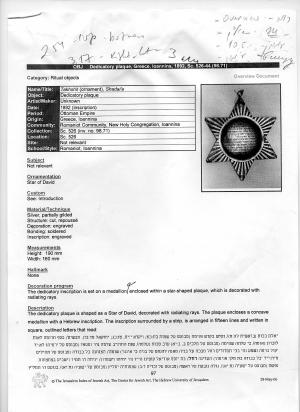Obj. ID: 5648
Sacred and Ritual Objects Dedicatory plaque, Ioannina, 1892

The dedicatory plaque is shaped as a Star of David and is decorated with radiating rays. The plaque encloses a concave medallion with a Hebrew inscription. The inscription surrounded by a strip, is arranged in fifteen lines and written in square, outlined letters that read:
" 'אלון בכות' (בראשית לה:ח)/ נקדש בקדש פנימה (מבוסס על שמות כח:כט; ויקרא י:יח, טז:כג; יחזקאל מד:כז). תכשיט/ כסף תרומה לאות לזכרון נאומה/ כי עלתה שמימה (מבוסס על מלכים ב, ב:יא) ערב סכות נעלמה/ שנת התרנ"ב עלמה נהי ומספד (מבוסס על ירמיהו לא:יד, 'קול ברמה נשמע נהי בכי תמרורים רחל מבכה על בניה מאנה להנחם על בניה כי איננו') שומה/ הצנועה כל כבודה (מבוסס על תהילים מה:יד, 'כל כבודה בת מלך פנימה') העדינה רחל/ בת יוסף אוריאל קופינו הי"ו (ה' יחיהו וישמרו)/ יניחה ה' תמיד וישביע בצחצחות נפשה (מבוסס על ישעיה נח:יא)/ גולה נובעת על ראשה (מבוסס על זכריה ד:ב) עצמותיה יחליץ (מבוסס על ישעיה נח:יא)/ בנועם ה' תמליץ יושבת בסתר עליון (מבוסס על תהילים כז:ד, ה; צא:א) מסתתרת/ ברום חביון (מבוסס על חבקוק ג:ד, 'ושם חביון עזו') בצל שדי תתלונן (מבוסס על תהלים צא:א) מטוב ה'/ ומזיוו תכונן לראות פני ה' (לפי שמות לד:כד) ולבקר בהיכלו/ לפני בקודש פנימה תחת ימין ה' רוממה (לפי תהילים קיח:טז)/ והובא בקדש קק"ח (קהל קדוש חדש) יכב"ץ (יכוננה בצדק) יום א/ סכות ש' (שנת) תרנ"ג."
This inscription is a compilation of different Biblical verses bearing eschatological implications (see: Remarks: no. 2).
"(This plaque is like) the oak of weeping (alon-bakhut, Gen. 35:8), and was dedicated into the Sanctuary (based on Ex. 28:29; Lev. 10:18, 16:23; Ezek. 44:27). The silver ornament is a donation as a sign and a declaration for the memory of (the one), who ascended to heaven, on the eve of Sukkot (the Feast of Tabernacles). The young woman disappeared (passed away), in the year 5652 (23.9.1891), (regarded as) a year of lamentation and 'bitter weeping' (based on 'Thus saith the Lord; A voice was heard in Ramah, lamentation, and bitter weeping; Rachel weeping for her children, refused to be comforted for her children, because he was not', Jer. 31:15). The humble one, whose glory (is within; based on 'the king's daughter is glorious within', Ps. 45:13) the gentle Rachel, daughter of Uriel Coffino, may the Lord sustain and protect him. May the Lord 'guide thee continually, and satisfy the soul in drought' (based on Isa. 58:11), 'a bowl (of oil) shall be upon her head' (based on Zech. 4:2), and 'may He make fat thy bones' (based on Isa. 58:11).
May she 'behold the beauty of the Lord, and dwell in the secret place of the most High' (based on Ps. 27:4, 5; Ps. 91:1). Hiding within the high secret place, and 'abide under the shadow of the Almighty' (Ps. 91:1) may she enjoy the Lord's goodness and be established by His brightness, 'to appear before the Lord' (Ex. 24:24) and see His face, 'while visiting His Shrine' (based on 'and to enquire in His temple', Ps. 27:4). (The plaque was dedicated) unto the Sanctuary (based on Ex. 28:29; Lev. 10:18, 16:23; Ezek. 44:27) 'under the exalted right hand of the Lord' (based on Ps. 118:16) and brought to the New Holy Congregation, may it be established with justice, (on) the first day of Sukkot (the Feast of Tabernacles) of the year 5653 (4.10.1892)."
A suspension ring inserted through loop is attached to the top of the plaque.
- The name רחל (Rachel) is marked in large letters.
This inscription is a rhyming compilation of variuos verses, which bear eschatological implications, alluding to the death of the young woman Rachel, who passed away on the eve of Sukkot. The donor made an analogy between her death and the pilgrimage to the Temple on Sukkot. Similar to the worshipers who ascended to the Temple Mount, Rachel ascended to the Heavens to "see His face, while visiting His Shrine."
sub-set tree:
objects known as shadai'ot (shadai'a in singular). The custom of
donating these plaques is common among the Greek Romaniot communities. The name shadai'a is derived from God’s name, "אל שדי" (El Shadai = God Almighty) which usually heads the dedicatory inscription. The plaque is also called a "takhshit," namely an ornament, which adorns the Torah, a term often inscribed on the plaques. This shadai'a is part of a larger group of plaques, documented in several collections around the world, which together forms the most comprehensive collection of shadai'ot.
The dedication of silver plaques as sacred objects is unique to the Greek Romaniot communities. Some inscriptions do reveal that occasionally they were donated with other ritual objects, such as a Torah scroll, a parokhet, or a mappah. Yet, unlike the common custom in other communities, they were not attached to specific ritual objects at the time of the donation. When a large number of shadai'ot plaques were assembled in a synagogue they were sewn on to a parokhet in a reversed "Π" shape. Some were also attached to Torah case wrappers or belts, which were probably hung along the walls of the synagogue on different occasions.
Although the events mentioned in the dedicatory inscriptions occurred at different times, the plaques were consistently donated to the synagogue on special days in the Jewish Year. The three pilgrimage festivals (Passover, Shavu'ot, Sukkot) are common, as well as Rosh Ha-Shanah, Yom Kippur, Rosh Hodesh (the New Moon) and Sabbaths. Rarely does the date of the donation mentioned on the plaque indicate another day of the week.
The custom was practiced among the Romaniot communities of Arta, Ioannina, Previzia, and is still practiced in Trikala and Larissa. No differences were noticeable between the two congregations in Ioannina concerning shape, dedicatory formulas or names of donors. The only distinction between the Old and New Holy Congregations is the name of the synagogue (when it appears). Most contemporary shadai'ot from Trikala and Larissa differ from the others and are shaped as Stars of David enclosed within circles. Few of them maintain the early linguistic dedicatory formulas.
The shadai'ot are important historical documents, which reflect both the artistic and the cultural heritage of the Romaniot communities in Greece. Their importance goes beyond the art of sacred objects; this unique custom offers a fascinating window to the rich Greek Jewish culture in the past four hundred years.
The dedicatory inscription is set on a medallion enclosed within a star-shaped plaque, which is decorated with radiating rays.
- There were two synagogue compounds in Ioannina: the Old Holy Congregation and the New Holy Congregation. The Old Congregation Synagogue was probably built in the 17th century, although its name for the first time appeared on a dedicatory plaque dating to 1726 (see: Sc. 525-215). The fact that the Old Congregation Synagogue is mentioned only from this date onward indicates the establishment of a new synagogue – namely the New Holy Congregation and probably reflects the need to distinguish between the two synagogues.
The plaque was donated to the Museum by the Jewish community of Ioannina on 29.06.98.
- Amar, Ariella, and Irina Chernetsky. Shadai'ot: The Collection of the Jewish Museum of Greece.Jerusalem: The Center for Jewish Art, TheHebrewUniversity ofJerusalem, 2006. Internal publication.







